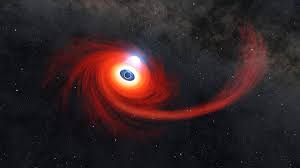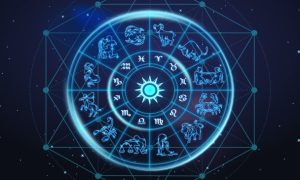In the vast expanse of the cosmos, there is much more than meets the eye. For every kilogram of visible matter in the universe, from the computer on your desk to the distant stars and galaxies, there are 5 kilograms of invisible “dark matter” that permeate our surroundings.
This enigmatic dark matter evades direct observation yet exerts its invisible pull on the visible objects around us.
Read More:- Aliens Live Among Us? Controversial Harvard Paper Explains How
Stephen Hawking and primordial black holes
Fifty years ago, renowned physicist Stephen Hawking proposed a fascinating idea about the nature of dark matter. He suggested that it might consist of a population of black holes that formed in the early stages of the universe, mere moments after the Big Bang.
These “primordial” black holes would not have been the colossal entities we detect today, but rather microscopic regions of ultradense matter.
According to Hawking’s theory, these primordial black holes would have formed in the first quintillionth of a second following the Big Bang, collapsed, and scattered across the cosmos, influencing the surrounding space-time in ways that could explain the dark matter we observe today.
Read More:- “Chance for them to seek a recusal”: Experts say Judge Cannon could give Jack Smith ammo to boot her
Super-charged black holes
Now, physicists from the Massachusetts Institute of Technology (MIT) have made a mind-bending discovery that sheds new light on Hawking’s idea.
David Kaiser, the Germeshausen Professor of the History of Science and professor of physics at MIT, and his graduate student Elba Alonso-Monsalve, found that the primordial process described by Hawking would have also produced some unexpected companions: even smaller black holes with unprecedented amounts of a nuclear-physics property known as “color charge.”
These smallest, “super-charged” black holes would have been an entirely new state of matter, likely evaporating a fraction of a second after their formation.
Despite their brief existence, they could have influenced a crucial cosmological transition: the time when the first atomic nuclei were forged.
Read More:- Manta Ray submarine drone seemingly spotted on Google Maps at California naval base
“Even though these short-lived, exotic creatures are not around today, they could have affected cosmic history in ways that could show up in subtle signals today,” explains Kaiser. “Within the idea that all dark matter could be accounted for by black holes, this gives us new things to look for.”
Ultradense matter in the early universe
Unlike the black holes we know and detect today, which are the product of stellar collapse, primordial black holes are thought to have formed in a time before stars existed.
In the early universe, before even the basic elements had formed, pockets of ultradense, primordial matter could have accumulated and collapsed to form microscopic black holes.
These black holes could have been so dense as to squeeze the mass of an asteroid into a region as small as a single atom.
Read More:- Scientists unveil ‘missing’ law of nature in landmark discovery
The gravitational pull from these tiny, invisible objects scattered throughout the universe could explain the dark matter that we can’t see today.
Very fleeting existence
Kaiser and Alonso-Monsalve set out to investigate the composition of these primordial black holes. They looked at existing theories for the likely distribution of black hole masses as they were first forming in the early universe.
“Our realization was, there’s a direct correlation between when a primordial black hole forms and what mass it forms with,” says Alonso-Monsalve. “And that window of time is absurdly early.”
The researchers calculated that primordial black holes must have formed within the first quintillionth of a second following the Big Bang.
Read More:- Homeowner Spots Two Women Using His Outside Chairs, Decides To Take Action
This brief flash of time would have produced “typical” microscopic black holes with masses ranging from an asteroid to an atom.
It would have also yielded a small fraction of exponentially smaller black holes, with the mass of a rhino and a size much smaller than a single proton.
Understanding quantum chromodynamics (QCD)
To determine the composition of these primordial black holes, Kaiser and Alonso-Monsalve turned to studies exploring the composition of the early universe, specifically focusing on the theory of quantum chromodynamics (QCD).
QCD describes how quarks and gluons, the fundamental building blocks of protons and neutrons, interact.
Immediately following the Big Bang, physicists estimate that the universe was an immensely hot plasma of quarks and gluons that quickly cooled and combined to produce protons and neutrons.
The researchers found that within the first quintillionth of a second, the universe would still have been a soup of free quarks and gluons that had yet to combine.
Any black holes forming during this time would have swallowed up these untethered particles, along with an exotic property known as “color charge” – a state of charge that only uncombined quarks and gluons carry.
Read Moer:- Scientists discover gigantic ‘structure’ under the surface of the Moon
“Once we figured out that these black holes form in a quark-gluon plasma, the most important thing we had to figure out was, how much color charge is contained in the blob of matter that will end up in a primordial black hole?” explains Alonso-Monsalve.
Exotic color charge properties
Using QCD theory, Kaiser and Alonso-Monsalve worked out the distribution of color charge that should have existed throughout the hot, early plasma.
They then compared that to the size of a region that would collapse to form a black hole in the first quintillionth of a second.
Interestingly, they found that most typical black holes at the time wouldn’t have contained much color charge, as they would have formed by absorbing a huge number of regions with a mix of charges, ultimately adding up to a “neutral” charge.
However, the smallest black holes would have been packed with color charge. In fact, they would have contained the maximum amount of any type of charge allowed for a black hole, according to the fundamental laws of physics.
These “extremal” black holes, although hypothesized for decades, had never been linked to a realistic formation process in our universe until now.
Read More:- Heat at Trump Las Vegas rally sends 6 to hospital, fire department says
Searching for signs in the form of imprints
The super-charged black holes would have quickly evaporated, but possibly only after the time when the first atomic nuclei began to form, around one second after the Big Bang.
This would have given the extremal black holes ample time to disrupt the equilibrium conditions that would have prevailed when the first nuclei began to form.
“These objects might have left some exciting observational imprints,” muses Alonso-Monsalve. “They could have changed the balance of this versus that, and that’s the kind of thing that one can begin to wonder about.”
Such disturbances could potentially affect how those earliest nuclei formed, in ways that might someday be observed by astronomers with future measurements.
If such observations are made, they would point convincingly to primordial black holes as the root of all dark matter in the universe today.
Read More:- Biden vs. Trump: Here’s what the next president means for your taxes
Dark matter, the universe, and the fabric of reality
In summary, this important study by Kaiser and Alonso-Monsalve opens up a new frontier in our understanding of the early universe and the nature of dark matter.
By exploring the formation and composition of primordial black holes, the researchers highlight a fascinating possibility that could revolutionize our understanding of the cosmos.
As we continue to unravel the mysteries of the universe, studies like this remind us of the incredible complexity and beauty that lies hidden in the fabric of reality.
The quest to understand dark matter and the origins of the universe is an ongoing journey, and with each new discovery, we inch closer to unlocking the secrets of the cosmos.



































